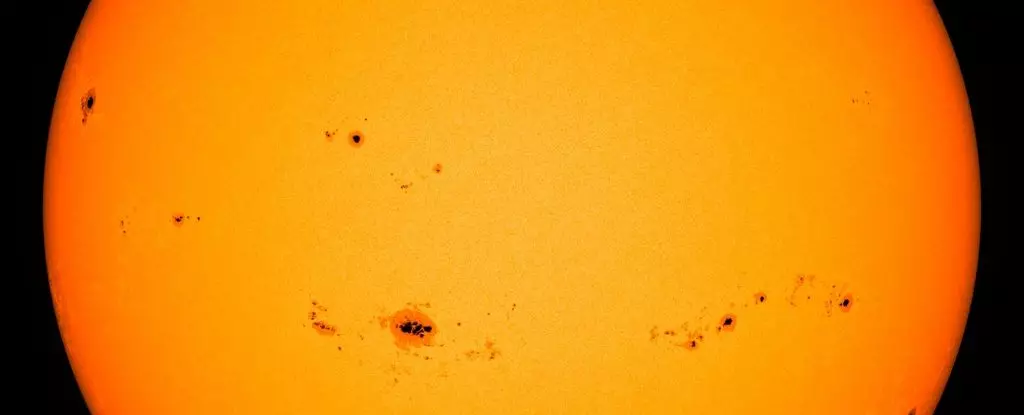As Earthlings gaze upon the sky, a powerful force is at play in the universe: our very own Sun. NASA, alongside the National Oceanic and Atmospheric Administration (NOAA) and the Solar Cycle Prediction Panel, has unveiled that we have officially entered a phase known as solar maximum. This phenomenon marks the apex of an 11-year solar activity cycle characterized by an increase in sunspots, solar flares, and coronal mass ejections. Unlike the steadiness we might perceive in daylight, the Sun experiences a constant ebb and flow of energy and magnetic activity—a process that can significantly affect both Earth and its inhabitants.
What should we expect from solar maximum?
The solar maximum period indicates the beginning of heightened solar activity. During this time, the Sun’s magnetic poles are expected to reverse, a process known as solar magnetic reversal. The overall excitement culminates in the characteristic sunspot activity that scholars utilize to gauge the intensity of the solar cycle. But contrary to popular belief, even though we can identify that we are currently in solar maximum, pinning down when peak activity will occur remains a challenge for scientists. Meteorologist Elsayed Talaat of NOAA emphasized this uncertainty: the moment of peak solar activity may remain elusive for years to come.
The implications of this solar ruckus extend beyond mere curiosity. Solar flares and coronal mass ejections are tangible outcomes of this solar maximum, and their effects can ripple through our technology-dependent lives here on Earth. While solar flares can cause radio blackouts, coronal mass ejections can lead to geomagnetic storms, which hold the potential to disrupt electricity grids, communication systems, and satellite operations.
Despite the existence of these cycles spanning approximately 11 years, scientists still wrestle with the underlying mechanisms that drive them. Solar dynamics remain one of the enigmas of astrophysics. Notable astrophysicists, such as Michael Wheatland from the University of Sydney, have pointed out the gaps in our understanding of the solar dynamo—the engine that produces the Sun’s magnetic fields. This lack of clarity hampers our ability to make dependable predictions about future solar activity, including the exact timing and strength of forthcoming cycles.
To keep track of the solar cycle, scientists measure sunspots, which are regions marked by concentrated magnetic activity. These areas present a stark contrast to the surrounding solar surface due to their cooler temperatures, visually resembling freckles on a sun-kissed face. During solar minimum, sunspots are scarce, while during maximum, they abound, serving as indicators that larger solar disruptions are imminent.
Effects on Earth and Human Technology
As solar activity intensifies, the interaction between solar outbursts and Earth’s magnetosphere becomes increasingly pronounced. The phenomena associated with solar maximum can produce geomagnetic storms triggered by coronal mass ejections colliding with the Earth’s magnetic field. Such storms not only present risks to various forms of technology, including satellites and power grids, but also create awe-inspiring displays in the form of auroras. This year has already seen an upsurge in auroral activity, a captivating result of space weather phenomena.
While the current solar cycle appears to be stronger than initial projections from NASA and the NOAA, it has not breached historical norms. The X9.0 flare recorded on October 4 stands among the most intense ever documented, yet it merely scratches the surface of potential solar activity observed in cycles past. This leaves us wondering about the thresholds and characteristics of extreme solar events.
As we navigate this significant solar event, it’s important to highlight that despite the excitement and potential dangers, we are not facing any direct threat at the moment. The observations from this cycle couple with intriguing studies from scientists who have accurately anticipated stronger solar activity. These findings could reshape our knowledge of solar physics and refine the predictive models employed in forecasting future cycles.
In light of the current solar activity, researchers are poised to glean critical insights regarding solar behavior and its influence on terrestrial systems. The implications of these insights could range from better preparation for potential technological disruptions to an enriched comprehension of solar dynamics that have broader cosmological significance.
Engaging with the dynamics of solar maximum allows us to appreciate the Salience of our Sun not just as a celestial body, but as a catalyst for scientific inquiry and understanding. While it flickers and roars, it continuously challenges humanity to decipher its mysteries—an endeavor that holds the potential to enhance our relationship with the cosmos itself. As we embrace the impending stormy space weather, our quest for knowledge continues amidst the formidable presence of our magnificent Sun.


Leave a Reply